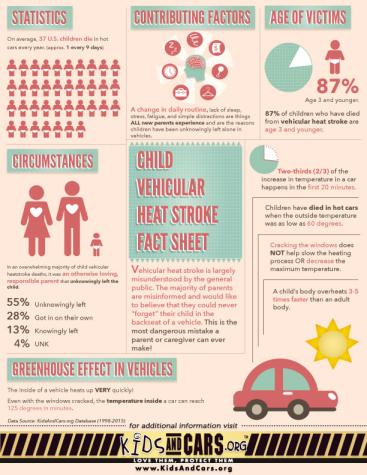Writer
Curt WohleberCOLUMBIA, Mo. – When the news has another tragic story about a child accidentally left in a hot car, parents might believe they could never make a mistake like that.
“It’s not just negligent parents or indifferent caregivers. When juggling the demands of work, parenting and daily life, it’s easier than you might think to make a simple but fatal mistake,” says Karen Funkenbusch, University of Missouri Extension health and safety specialist.
On average, 37 children die in the U.S. each year from heatstroke in cars, according to the nonprofit child-safety organization Kids and Cars. That’s one child every nine days. And there are hundreds of cases of nonfatal heat-related illness every year, some of which result in permanent brain damage.
Pets, the elderly and people with movement disabilities are also at risk, Funkenbusch notes.
The 2010 death of Jahzel Piñon was the tragic result of miscommunication between parents, as Jahzel’s mother, Stephanie Piñon, recounts on the Kids and Cars website. Piñon was running late for a meeting one morning, she writes, when her husband helpfully buckled their 2-year-old daughter in the back of the family minivan while Piñon finished getting ready. She drove off thinking Jahzel was at home with dad. She had no idea that the shy, quiet toddler was in the minivan until she returned to her parked vehicle several hours later. An ambulance rushed Jahzel to the hospital, where she died 90 minutes after arrival. In addition to the grief and loss, Piñon faced criminal prosecution and the possibility of years in prison. She agreed to a plea deal and was sentenced to five years of probation.
Funkenbusch warns parents that leaving a child in car for even a few minutes is dangerous. The cool interior of an air-conditioned car can quickly turn deadly once you shut off the engine. Within 10 minutes the inside temperature can rise more than 20 degrees. After an hour, temperatures can increase by 40 degrees or more, according to a 2005 study published in the journal Pediatrics. The same study revealed that leaving windows open an inch or two won’t stop a car in direct sunlight from quickly becoming dangerously hot.
“You might think you’ll be just a few feet away for a few seconds,” Funkenbusch says. “But modern life is full of distractions — an urgent phone call, a broken ATM, a chance encounter with a friend.”
The danger of heatstroke in cars isn’t confined to hot days. Even when the outside temperature is only in the mid-60s, sunlight can heat the interior to 110 degrees or more, according to the National Highway Transportation Safety Administration (NHTSA).
Tips from NHTSA
For parents and caregivers:
- Look before you lock. Make a habit of always checking the back seat of your vehicle before walking away.
- Place a needed item such as your phone, briefcase or purse in the back seat. That way, you’ll see your child when you retrieve the item.
- Keep your vehicle locked and keys out of reach of children. Almost 30 percent of vehicle-related heatstroke deaths happen when an unsupervised child climbs inside a vehicle.
For bystanders who see a child alone in a vehicle:
- Make sure the child is OK. If not, call 911 immediately.
- If the child appears to be OK, try to find the parents. If at a store or other facility, try to have the car owner paged over the PA system.
- If the child is unresponsive and appears to be in distress, attempt to get into the car to help the child, even if that means breaking a window.
More resources
- “Look Before You Lock,” National Highway Transportation Safety Administration, nhtsa.gov/heatstroke-kills-children.
- “Where’s Baby?” (video), National Weather Service, youtu.be/EfIHo52hLl8.
- Kids and Cars, kidsandcars.org.
Originally published June 20, 2018.
